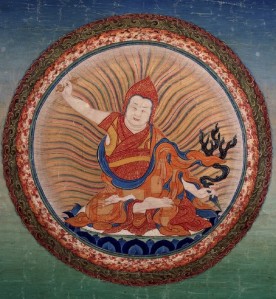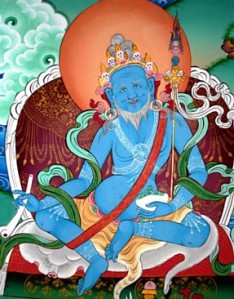During a break in Tashiding, Rinpoche called his students and friends outside to give a brief explanation about Lhatsun Namkha Jigme (1597-1654), the Tibetan visionary-saint and the author of the Riwo Sangcho smoke offering practice that many of us do.
Lhatsun Chenpo Namkha Jigme was an incarnation of both the great pandit and Dzogchen master Vimalamitra, who attained the ja lü phowa chenpo, and of the omniscient Longchenpa. He was born in 1597 at Jaryül in southern Tibet. At birth, the space between his eyebrows and the tips of his tongue and nose were all very clearly marked with the seed-syllable AH.
He was ordained as a novice in 1607 by Tulku Orgyen Paljor and was given the name Kunzang Namgyal. He particularly practised the Kagye (the ‘Eight Great Herukas’) and Lama Gongdu, completely mastering all the accomplishments and enlightened activities of these practices.
He stayed for seventeen years with Dzogchenpa Sonam Wangpo, receiving the complete instructions of Nyingtik, and from Ngawang Mikyo Dorje he received thorough instruction on the profound and secret yogic practices known as ‘The Path of Skillful Means’ (thap lam), and its attendant activities known as ‘the disciplined conduct of awareness’. He was the heart-disciple of both Rigdzin Jatson Nyingpo and Terton Dudul Dorje, Jatson Nyingpo principally transmitted to him the Ratnasamanyasamgha, Konchok Chidu teachings, as a lineage holder. He became a supreme practitioner of all these teachings and many lamas consider that since his time no one has displayed such complete mastery.
Namkha Jigme was himself a terton, he was the discoverer of the “Attainment of the Vidyadhara Life” (rig ‘dzin srog sgrub), from which the famed “Riwo Sangcho (ri bo bsang mchod)” comes from and “The Spontaneous Song of the Clouds: the Nucleus of Indestructible Reality” (rdo rje snying po sprin gyi thol glu)
Through his practice of Riwo Sangcho, he was able to remove all human and non-human obstacles to the Dharma in Sikkim, opening it as a ‘secret land’ of the teachings. Because of this, he was able to teach Dzogchen very widely in Sikkim in the remaining years of his life, establishing a vibrant and unbroken lineage that continues to this day, known simply as ‘Sikkim Dzogchen’. Encouraged by Jatson and Dudul, Lhatsun Namkha Jigme along with Kathok Rigdzin Chenpo and Ngadak Sempa Phuntsok went to Sikkim in the water horse year of the Tibetan calendar corresponding to 1642 A.D, they established the Royal Phuntsok Namgyal Dynasty by choosing young Bhutia Phuntsok Namgyal, who became the first Chogyal (Dharma King) of Sikkim.
More than two hundred of Lhatsun Namkha Jikmé’s writings have survived. Accomplishing the Life-Force of the Vidyadharas and The Spontaneous Song of the Clouds have continued to be transmitted and practiced throughout Tibet and particularly in Sikkim right up to the present day without any decline. His incarnation, Jigme Pawo (1682-?) continued his work in Sikkim. His later incarnations include the Khyentse lineage; Jamyang Khyentse Chokyi Lodro states in his autobiography that he had clear memories of his past life as Lhatsun Namkha Jikme, and that he had been shown the tantric disciplines by Lhatsun in a vision.


No comments:
Post a Comment